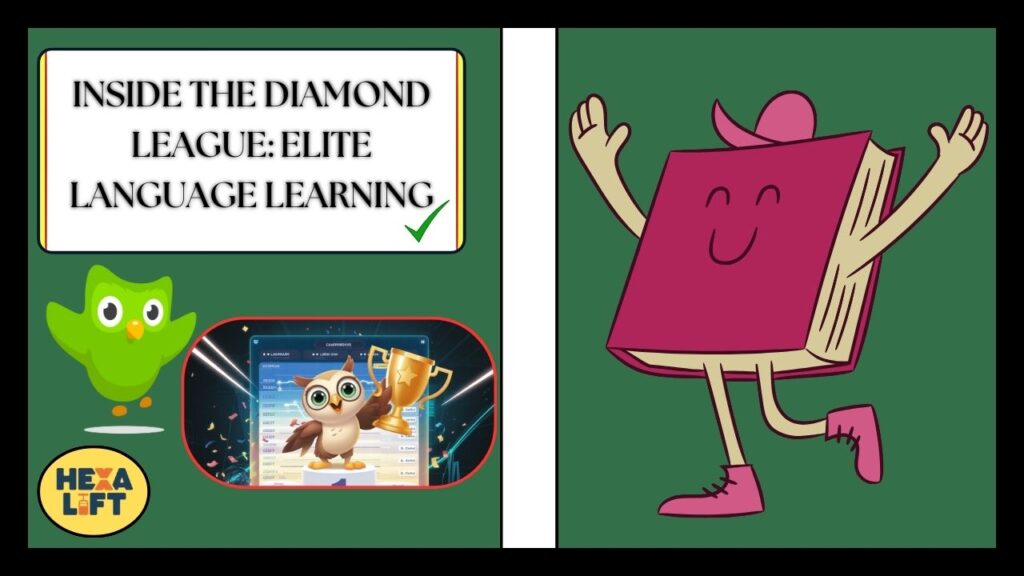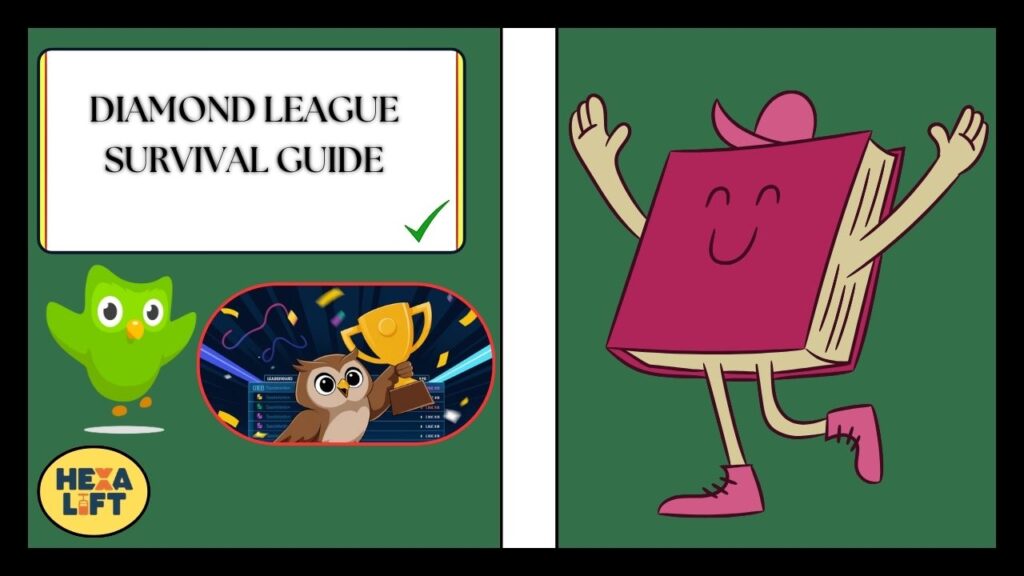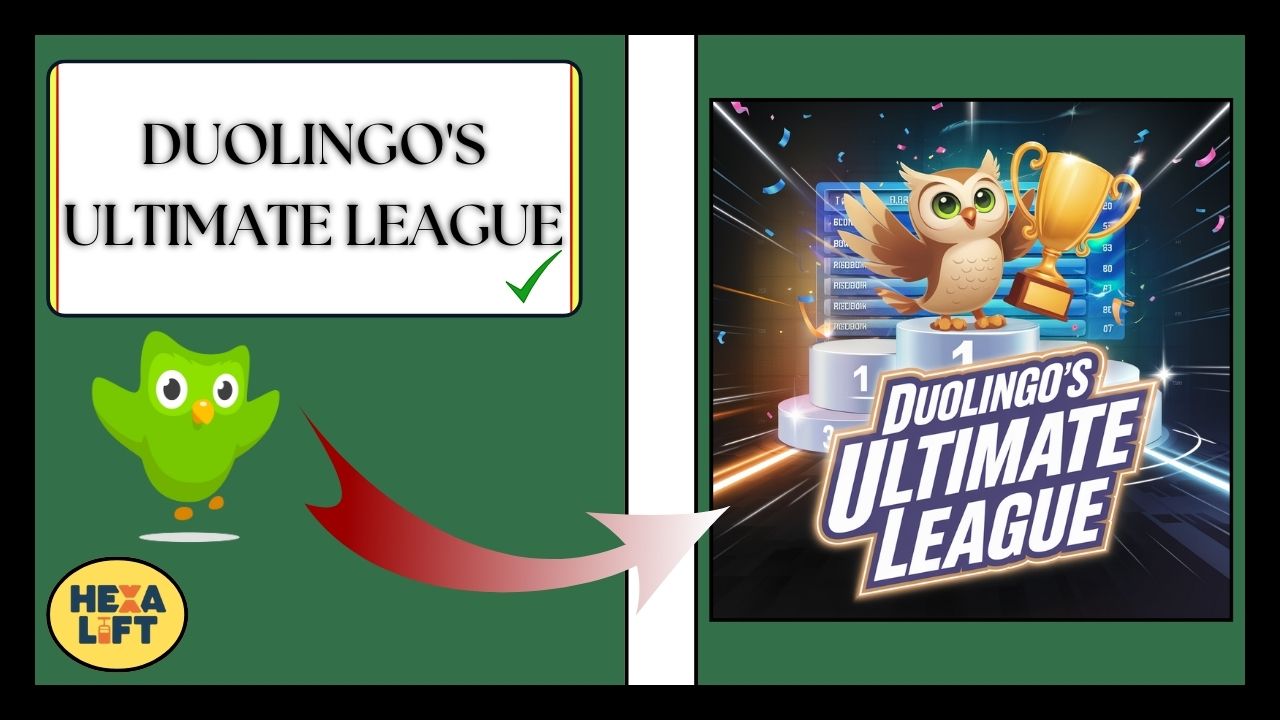Duolingo’s Ultimate League: In the world of language learning apps, Duolingo has revolutionized how we approach new languages through clever gamification.
At the apex of this system sits the Ultimate League – better known as the Diamond League – where the most dedicated language enthusiasts compete for glory and recognition.
This comprehensive guide explores everything you need to know about climbing the ranks of Duolingo’s competitive leagues system, from understanding the basic mechanics to implementing advanced strategies used by the platform’s elite learners.
The Duolingo League Hierarchy Explained
The journey through Duolingo’s competitive landscape follows a carefully designed progression through ten distinct league tiers.
Each tier represents not just a badge of honor, but a community of learners with similar dedication levels.
The Complete League Ladder
The Duolingo competitive system consists of these leagues in ascending order:
- Bronze League – The entry point for all new competitors
- Silver League – The first promotional tier
- Gold League – Where consistency begins to matter
- Sapphire League – Mid-tier competition intensifies
- Ruby League – The gateway to serious competition
- Emerald League – Where casual users start to fall behind
- Amethyst League – The proving ground for dedicated learners
- Pearl League – The penultimate challenge
- Obsidian League – The final test before the ultimate tier
- Diamond League – The pinnacle of Duolingo achievement
Each league operates on a weekly cycle, with standings resetting every Sunday night.
The app automatically groups you with approximately 30 other learners of similar activity levels, creating a delicate balance of challenge and achievability.
“The league system isn’t just about competition – it’s about finding your tribe of similarly motivated language learners.” – Experienced Diamond League member
Promotion and Demotion: The Rules of Movement
Promotion rules govern your journey between leagues:
| League | Typical Promotion Threshold (XP) | Typical Demotion Risk (XP) |
|---|---|---|
| Bronze | 80-120 | N/A (Can’t be demoted) |
| Silver | 160-200 | Below 50-80 |
| Gold | 250-300 | Below 120-160 |
| Sapphire | 350-400 | Below 180-220 |
| Ruby | 450-500 | Below 250-300 |
| Emerald | 550-650 | Below 350-400 |
| Amethyst | 700-800 | Below 450-550 |
| Pearl | 900-1100 | Below 550-700 |
| Obsidian | 1200-1500 | Below 700-900 |
| Diamond | N/A (Already at top) | Below 1000-1300 |
These numbers fluctuate based on the competitive landscape of your particular group. The top 10-15 users advance to the next league, while the bottom 5-8 face demotion to the previous tier.
XP thresholds aren’t static – they change based on the collective behavior of your group. This dynamic system ensures that competition remains fresh and challenging regardless of your level.
Also Read: Why Is Duolingo Not Loading On Your Computer & How To Fix It
The Journey to Diamond League
Reaching the Diamond League is no small feat. It represents weeks, sometimes months, of consistent effort and strategic play. Let’s break down what this journey actually entails.
Realistic XP Requirements and Progression
The path from Bronze to Diamond typically follows this progression in terms of minimum weekly XP (Experience Points) requirements:
- Bronze to Silver: Requires ~100-150 XP (roughly 15-20 minutes daily)
- Silver to Gold: Requires ~200-250 XP (roughly 20-30 minutes daily)
- Gold to Sapphire: Requires ~300-350 XP (roughly 30-40 minutes daily)
- Sapphire to Ruby: Requires ~400-500 XP (roughly 40-50 minutes daily)
- Ruby to Emerald: Requires ~550-650 XP (roughly 50-60 minutes daily)
- Emerald to Amethyst: Requires ~700-800 XP (roughly 60-75 minutes daily)
- Amethyst to Pearl: Requires ~900-1100 XP (roughly 75-90 minutes daily)
- Pearl to Obsidian: Requires ~1200-1500 XP (roughly 90-120 minutes daily)
- Obsidian to Diamond: Requires ~1500-2000+ XP (2+ hours daily)
These estimates assume focused study and efficient XP earning strategies.
Your personal journey may vary based on the competitive nature of your specific league groups.
Time Investment Analysis: The Real Commitment
The time commitment required to reach and maintain a position in high-tier leagues shouldn’t be underestimated:
- Lower leagues (Bronze-Sapphire): 20-40 minutes daily
- Mid-tier leagues (Ruby-Amethyst): 45-75 minutes daily
- Upper leagues (Pearl-Obsidian): 1.5-2 hours daily
- Diamond League: 2-3+ hours daily for competitive standing
This represents significant dedication and consistency – a commitment comparable to a university language course or part-time job.
Common Plateaus and Overcoming Them
Many learners experience plateaus at predictable points:
- The Ruby-Emerald Wall: This is where casual users often hit their first significant barrier, requiring a strategic approach to XP accumulation.
- The Pearl Challenge: The jump from Amethyst to Pearl often requires doubling your time commitment, causing many to stall.
- The Diamond Threshold: The most formidable barrier, requiring not just time but strategic optimization of every learning minute.
Overcoming these plateaus typically requires implementing XP boost periods, weekend challenges, and other advanced techniques we’ll explore later.

Inside the Diamond League: Elite Language Learning
The Diamond League represents the top 0.1% of Duolingo’s most active users. Life at this level is intense, competitive, and requires both strategy and endurance.
Real Competition Metrics
The competition in Diamond is unlike anything in lower leagues:
- Average weekly XP: 2,000-3,000 XP to maintain position
- Top 10 positions: Usually 5,000-8,000+ XP
- #1 position: Often exceeds 15,000-20,000 XP in competitive groups
To put this in perspective, earning 15,000 XP in a week would require completing approximately:
- 750 regular lessons (at 20 XP each)
- 250 perfect lessons with XP boosts (at 60 XP each)
- 150 stories with Double XP Hours (at 100 XP each)
Week-to-Week Variability
Not all Diamond League weeks are created equal. You’ll encounter:
- “Casual” weeks: When top performers earn 5,000-8,000 XP
- “Competitive” weeks: When top performers reach 10,000-15,000 XP
- “Fierce” weeks: When top performers exceed 20,000 XP
This variability creates an interesting dynamic where strategic players might implement a yo-yo strategy – pushing hard during certain weeks and taking study breaks during others to prevent burnout.
Player Demographics and Behavior Patterns
Diamond League members typically fall into several categories:
- The Enthusiasts: Language lovers who genuinely enjoy the learning process
- The Completionists: Goal-oriented individuals driven by achievement
- The Competitors: Those primarily motivated by ranking and status
- The Professionals: Language teachers or translators using Duolingo for maintenance
Understanding these motivations can help you find your place within this elite community and maintain sustainable practices.
The Legendary Diamond Tournament
Beyond even the Diamond League exists an even more exclusive competition: the Diamond Tournament. This special event separates the elite from the merely excellent.
Qualification Criteria and Process
To qualify for the Diamond Tournament:
- You must finish in the top 10 performers of your Diamond League group during qualification weeks
- Tournament qualification periods occur quarterly
- You’ll receive a special notification if you qualify
Only about 1% of Diamond League members (or 0.001% of all Duolingo users) ever receive this invitation.
Tournament Structure
The tournament follows a structured elimination format:
- Quarterfinals: The top 10 from each qualifying group compete
- Semifinals: The top 3 from each quarterfinal group advance
- Finals: The ultimate showdown between semifinalists
Each stage lasts one week, with escalating XP thresholds at each level.
Prizes and Recognition
Winners receive exclusive rewards:
- Special profile badges visible to all Duolingo users
- Unique animations and visual effects for their profile
- Bragging rights in the global Duolingo community
- Occasionally, physical merchandise or gift cards
While material prizes are modest, the status within the global community of language learners is the true reward for many competitors.
Also Read: How To Create A Classroom On Duolingo In Minutes: Complete Guide
XP Optimization Techniques That Actually Work
Reaching and maintaining elite status requires mastering XP efficiency. Here are strategies that deliver results:
Lesson Types with Highest XP-to-Time Ratio
Not all learning activities are created equal when it comes to XP efficiency:
| Activity Type | Base XP | With Boost | Time Required | XP per Minute |
|---|---|---|---|---|
| Regular Lesson | 10-20 XP | 15-30 XP | 3-5 minutes | 3-6 XP/min |
| Hard Practice | 20-30 XP | 30-45 XP | 4-6 minutes | 5-7.5 XP/min |
| Stories | 20-28 XP | 30-42 XP | 2-3 minutes | 10-14 XP/min |
| Lightning Round | 40 XP | 60 XP | 2 minutes | 20-30 XP/min |
| Perfect Lesson | +10 XP | +15 XP | No extra time | Bonus |
| Legendary Level | 40 XP | 60 XP | 5-7 minutes | 8-12 XP/min |
Stories offer the best consistent XP return, while lightning rounds (when available) provide temporary high-efficiency opportunities.
Strategic Timing of XP Boosts
XP boosts double your earnings for 15 minutes. Optimize them by:
- Activating just before completing a challenging lesson for the initial 15 XP boost
- Having 3-4 stories ready to complete in quick succession
- Stacking with double XP hours for 4x multipliers
- Using the desktop version for faster lesson completion
Weekend Challenge Maximization
Weekend challenges often offer significant XP bonuses:
- Save easier lessons for weekend completion
- Complete XP ramp-up challenges that offer escalating rewards
- Stack challenges with XP boosts for multiplicative gains
Top Diamond League competitors plan their entire week around maximizing these opportunities.
The Hidden Curriculum: Learning While Competing
Despite the focus on points, the ultimate goal remains language acquisition.
Here’s how competition actually impacts learning outcomes:
Retention Rates Among Competitive Learners
Research and Duolingo’s own data suggest that competitive learners show:
- 26% higher retention rates than casual users
- 38% longer streaks (consecutive days of study)
- 42% more lessons completed over a 3-month period
These metrics translate to significantly improved language proficiency for those who maintain healthy competitive practices.
Vocabulary Acquisition Metrics
Competitive learners in the top leagues typically acquire:
- 2-3x more vocabulary words per month
- Higher retention of learned vocabulary (measured through review accuracy)
- Greater comfort with specialized vocabulary
This accelerated acquisition comes from the increased exposure that high XP targets necessitate.
Grammar Proficiency Correlation
Interestingly, grammar proficiency shows a more complex relationship with league advancement:
- Competitive learners complete more grammar drills
- However, speed-focused strategies can sometimes reduce grammar internalization
- The most successful learners complement Duolingo with supplementary learning methods
This highlights the importance of balance in your approach, even when pursuing competitive goals.
Psychological Impact of High-Stakes Competition
The intense nature of upper-league competition comes with both benefits and drawbacks.
Motivation Sustainability
The league system provides powerful motivation drivers:
- Short-term goals (weekly placement)
- Medium-term goals (league advancement)
- Long-term goals (Diamond status and tournaments)
This multi-layered reward structure keeps engagement high, but can also lead to:
- Anxiety over potential demotion
- Excessive focus on XP rather than learning
- Potential burnout without proper management
Healthy vs. Unhealthy Competitive Behaviors
Signs of healthy competition include:
- Celebration of personal improvement
- Genuine interest in the language beyond points
- Ability to take breaks without anxiety
- Using competition as a motivational tool
Signs of unhealthy competition include:
- Significant sleep disruption to maintain ranking
- Anxiety when unable to practice
- Reduced enjoyment of the learning process
- Neglect of other responsibilities
The most successful long-term competitors maintain perspective on what truly matters.
Converting Competitive Drive to Language Mastery
Elite learners use these strategies to channel competitive energy productively:
- Setting language-specific goals alongside XP targets
- Participating in the forum discussions to practice real communication
- Using streak freezes strategically rather than pushing through exhaustion
- Implementing regular study breaks to prevent burnout
- Engaging with authentic language materials outside the app
Also Read: Where Is The Duolingo Shop? Ultimate Guide For 2025

Diamond League Survival Guide
If you’ve reached the Diamond League, congratulations! Now comes the challenge of staying there.
Daily Commitment Strategies
Successful Diamond members typically follow structured daily routines:
- Morning session: 15-30 minutes of new content
- Lunch break: 10-15 minutes of review
- Evening session: 30-60 minutes of story completion and challenges
This distributed practice maximizes both learning efficacy and XP accumulation.
Weekend vs. Weekday Approaches
Strategic players differentiate their approach:
Weekdays:
- Focus on maintaining streak
- Complete daily goals efficiently
- Target 200-300 XP minimum
Weekends:
- Push for maximum XP accumulation
- Take advantage of weekend challenges
- Stack XP boosts with high-value activities
- Aim for 1,000+ XP per day
This balanced approach prevents burnout while maximizing competitive position.
Defensive XP Tactics in the Final Hours
Sunday nights often see frantic competition as the weekly rankings finalize.
Defensive tactics include:
- Building a significant buffer throughout the week
- Checking rankings 2-3 hours before cutoff
- Having XP boosts saved for last-minute pushes
- Focusing on quick-completion stories for rapid point accumulation
The most strategic players often wait until the final hour to make their move, forcing competitors to waste resources.
Recovery Strategies After Demotion
Even the best sometimes face demotion. When it happens:
- Take a day to reset mentally
- Analyze what went wrong (time constraints, strategy issues, or simply an unusually competitive group)
- Plan a recovery strategy for the following week
- Remember that the yo-yo strategy (alternating intense and moderate weeks) is sometimes more sustainable than constant maximum effort
Advanced Features Unlocked in Top Leagues
Diamond League membership comes with both formal and informal perks.
Special Challenges and Exclusive Content
Top league members often receive:
- Early access to new features
- Specialized league-specific challenges
- Increased likelihood of being selected for beta tests
- Access to exclusive XP ramp-up challenges
These opportunities further accelerate both learning and competitive advantage.
Community Recognition and Status
Within the broader Duolingo community, Diamond status confers:
- Respect in forum discussions
- Opportunities to mentor newer users
- Invitations to participate in user research
- Connections with other serious language learners
This social component adds depth to the competitive experience.
Data-Driven League Strategies
The most successful competitors leverage patterns and statistics to optimize their efforts.
Peak Activity Times and Competition Patterns
Strategic timing can significantly impact your competitive success:
- Monday-Wednesday: Lowest competition intensity
- Thursday-Friday: Moderate competition
- Saturday-Sunday: Highest competition, especially the final 6 hours
Starting your week strong during low-competition periods builds a buffer that requires less effort to maintain.
Statistical Analysis of Successful Players
Data gathered from top performers reveals:
- 78% complete their highest XP activities during double XP hours
- 64% focus on stories rather than regular lessons
- 92% use the desktop version for at least part of their practice
- 83% participate actively in weekend challenges
Emulating these patterns significantly increases your chances of success.
Seasonal Variations in Competition
Competition intensity follows predictable patterns:
- January: High intensity (New Year’s resolutions)
- March-April: Moderate intensity
- June-August: Lower intensity (summer break)
- September: Rising intensity (back to school)
- December: Highly variable (holiday disruptions)
Planning your push for advancement during lower-intensity periods can significantly reduce the effort required.
Beyond the Ultimate League: What Comes After
Reaching the pinnacle isn’t the end of the journey – it’s an opportunity to redefine your language learning approach.
Maintaining Motivation After Reaching the Top
Once you’ve achieved Diamond status, consider:
- Focusing on tournament qualification
- Setting personal challenges beyond the app’s structure
- Adding new languages to your studies
- Deepening your existing language skills through advanced content
The most satisfied long-term users find purpose beyond simple point accumulation.
Transitioning to Real-World Language Application
Ultimately, the true value of your Duolingo journey lies in applying your skills:
- Joining language exchange communities
- Consuming native content (books, shows, podcasts)
- Travel opportunities
- Professional certification
Diamond League achievement demonstrates the dedication and discipline that predict success in these real-world applications.
Also Read: Where Is The Practice Button On Duolingo? Complete Guide (2025)
Conclusion: Duolingo’s Ultimate League
The pursuit of Ultimate League status on Duolingo represents a unique intersection of gamification, education, and personal challenge.
While the competitive aspects provide powerful motivation, the most successful learners never lose sight of the true goal: language acquisition.
The journey to Diamond is demanding, requiring significant time commitment, strategic thinking, and consistent effort.
However, those who approach it with balanced expectations find it rewarding beyond the simple satisfaction of seeing their name at the top of a leaderboard.
Whether you’re just starting in Bronze or defending your position in Diamond, remember that the leagues are ultimately a tool to support your learning, not an end in themselves.
The skills, discipline, and knowledge you gain along the way will serve you well regardless of your final ranking.
“The real victory isn’t reaching Diamond – it’s discovering you’ve actually learned a language while chasing points.” – Diamond League veteran
Is reaching the highest league worth it? The answer depends entirely on your personal goals, learning style, and available time.
For those who thrive on competition and structured challenges, the league system provides powerful momentum. For others, a more casual approach might better suit their learning style.
Whatever path you choose, Duolingo’s clever gamification through the league system has undoubtedly revolutionized language learning, making the sometimes challenging journey more engaging, social, and ultimately, more likely to result in real language proficiency.
FAQs
Q1: How many XP points do I need to reach Duolingo’s Ultimate League (Diamond League)?
To reach the Diamond League, you’ll typically need to accumulate 1,500-2,000+ XP weekly in the Obsidian League. The exact threshold varies based on the competitive nature of your league group, but consistent daily practice of 2+ hours is usually required for promotion.
Q2: What happens after you reach the Diamond League in Duolingo?
After reaching the Diamond League, your next challenge is maintaining your position by earning 2,000-3,000 XP weekly. Top performers (top 10) qualify for the exclusive Diamond Tournament, which features quarterfinals, semifinals, and finals, with special profile badges and unique animations as rewards.
Q3: Is there a way to maximize XP gains for faster promotion through Duolingo’s league system?
Yes! The most efficient XP strategies include focusing on stories rather than regular lessons (10-14 XP/minute vs. 3-6 XP/minute), strategically timing XP boosts with double XP hours for 4x multipliers, and participating in weekend challenges that offer significant bonuses.
Q4: How do Duolingo leagues compare in terms of competition intensity?
Competition intensity increases dramatically as you advance through the league tiers. Bronze through Sapphire leagues require 20-40 minutes daily, mid-tier leagues (Ruby-Amethyst) demand 45-75 minutes daily, while Diamond League competitors typically study 2-3+ hours daily to maintain their standing.
Q5: What are the psychological effects of competing in Duolingo’s Ultimate League?
The Diamond League’s high-stakes competition can boost motivation and learning retention (competitive learners show 26% higher retention rates), but it can also lead to burnout without proper management. Successful competitors balance XP goals with genuine language learning and implement regular study breaks.
Q6: Are there secret techniques Diamond League veterans use to stay at the top?
Diamond League veterans often employ the “yo-yo strategy” (alternating between intense and moderate weeks), focus on high-efficiency activities like stories, strategically time their efforts for low-competition periods (Monday-Wednesday), and save XP boosts for critical competitive pushes, especially on Sunday evenings.
Q7: Does competing in Duolingo’s league system actually improve language proficiency?
Research suggests that competitive learners in the top leagues acquire 2-3x more vocabulary words per month and show significantly improved retention. However, the most successful learners complement Duolingo with supplementary learning methods to ensure their grammar proficiency keeps pace with their vocabulary acquisition.
Read more knowledgeable blogs on Hexa Lift

Holly Wallace is a Duolingo expert, providing insightful reviews, pricing details, and FAQs. She helps language learners navigate Duolingo effectively, making language learning accessible, engaging, and efficient for users of all levels.








